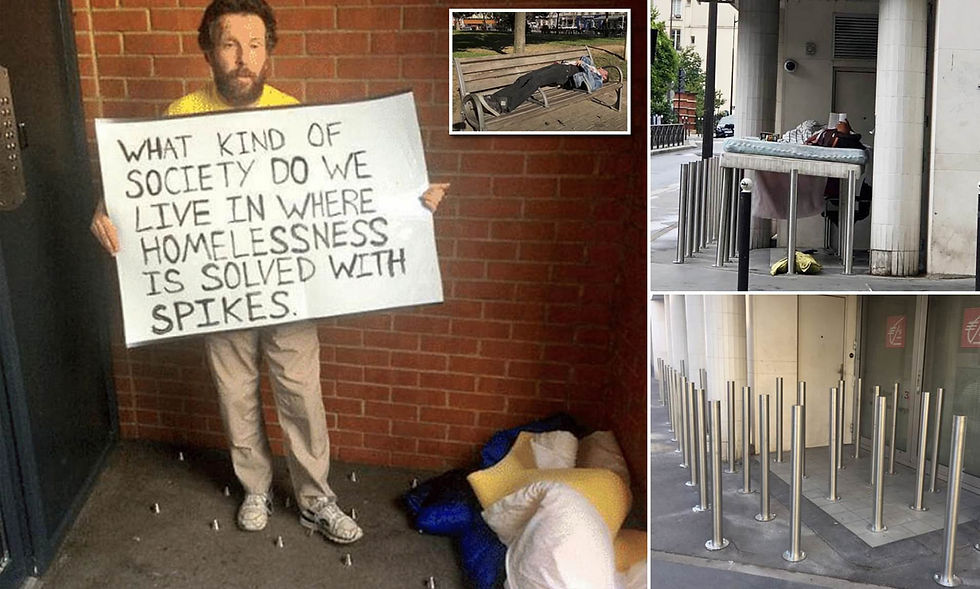Anti-Homeless Architecture and policies
- Amisha Patel
- Feb 19, 2021
- 3 min read
What does anti-homeless architecture look like?
Anti-homeless architecture, hostile architecture, or defensive design are specific structures meant to keep people within the houseless community from occupying those spaces. These structures seem harmless or like odd design choices to those not in the houseless community. The most common forms of hostile architecture are benches with distinct segments or arm rests, floor spikes, or spiked/raised grate covers. These structures make it harder for people without homes to sleep or keep warm when it is cold. Hostile architecture can be obvious like the pictures below or in some cases can be disguised as just pretty statutes or displays.

What is the impact of these structures?
The supposed purpose behind anti-homeless architecture, also called hostile architecture or defensive design, is to prevent or inhibit crime and maintain public order. This sentiment alone carries significant implications. The notion that hostile architecture is intended to prevent crime conveys to unhoused folks that their very existence is a crime that they will be punished for. Moreover, by prioritizing the aesthetic of the city and comfort of wealthier people, unhoused individuals are relegated to bottom tier citizens and deemed an unsightly nuisance. In essence, hostile architecture tells folks sleeping rough that undeserving of the bare minimum provisions, such as a stable, dry place to rest.
The implementation of hostile architecture also clearly delineates who exactly is allowed to utilize public spaces, which effectively creates a dichotomy of the “deserving public” and the “undeserving public” with unhoused folks being placed in the latter category. As we can see, there are countless psychological effects that result from the usage of hostile architecture; however, there are also countless physical effects as well. The most notable physical effect is long-term sleep deprivation as hostile architecture prevents unhoused folks from having even a slightly comfortable surface to sleep on. It should be noted that long-term sleep deprivation is considered a form of torture by most all human rights organizations. The rippling effects of sleep deprivation continue to take a toll on the unhoused community-- including causing further psychological damage. Further, if people are able to sleep on top of these hostile architecture structures, they are likely to suffer harm to their body, which would only be exacerbated over time. Overall, we can see the countless harmful effects of anti-homeless architecture as they take a toll on the mental and physical health of unhoused folks.

Current anti-homeless policies in Gainesville
Gainesville officials are now defending a law that can fine individuals who sit and stand at traffic medians. This defense comes under the notion that city officials are trying to keep the streets safe. The Gainesville city commission has given nods of support to an ordinance that would allow police to fine 50$ to anyone who sits in a median of 6ft wide or less, which includes many of the city’s intersections. The fine doubles on a second offence and a court date becomes mandatory on the third offense. Officials say this ordinance was proposed only with the thought of safety in mind as there have been injuries and deaths that have occurred to panhandlers who sit in those spots. Officials claim the ordinance is not anti-homeless because people can ask for money anywhere except for medians in concern for their safety. However this ordinance can disenfranchise many local homeless individuals who have been frequent sitters in medians of busy streets.

man asking drivers for money on SW 13th street near Archer road
Policies surrounding anti-homelessness
There is a gap between what has been codified into law and what is being practiced. “Devices that inhibit seating” were banned by the city, along with other characteristics that could deter the public from enjoying public spaces. However, there has been evidence of numerous violations related to city requirements designated for public spaces, even those owned privately.Policy may not necessarily be able to protect public amenities from being modified in a hostile way.
Sources:


Comments